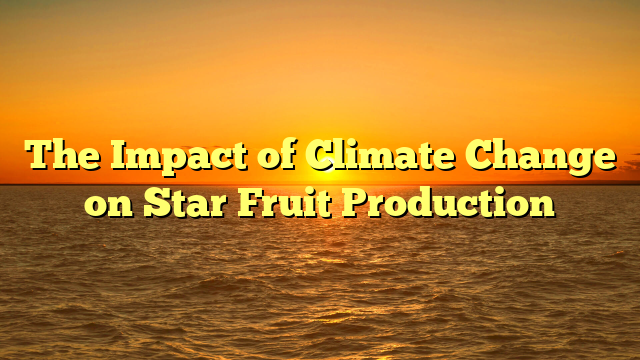
Star fruit (Averrhoa carambola), with its sweet-tart flavor and distinctive star-shaped slices, is a tropical fruit that thrives in warm, humid climates. However, as climate change continues to alter weather patterns and disrupt ecosystems, the production of star fruit—and many other crops—faces significant challenges. From unpredictable rainfall to rising temperatures, the effects of climate change are reshaping the agricultural landscape. Let’s explore how these changes are impacting star fruit production and what steps can be taken to mitigate the risks.
The Ideal Growing Conditions for Star Fruit
Star fruit is native to Southeast Asia and grows best in tropical and subtropical regions. The fruit requires:
– Warm Temperatures: Optimal growth occurs between 68°F and 95°F (20°C to 35°C).
– Consistent Rainfall: Adequate moisture is essential, but waterlogging can harm the roots.
– Well-Drained Soil: The trees thrive in fertile, well-drained soils with a slightly acidic to neutral pH.
These conditions make star fruit particularly vulnerable to the effects of climate change, which can disrupt the delicate balance required for its cultivation.
How Climate Change is Affecting Star Fruit Production
Climate change poses several threats to star fruit production, including:
1. Rising Temperatures
While star fruit thrives in warm climates, excessively high temperatures can stress the plants, reducing yields and affecting fruit quality. Prolonged heatwaves can also lead to water scarcity, as evaporation rates increase and soil moisture depletes.
2. Unpredictable Rainfall
Changes in precipitation patterns, including prolonged droughts and intense rainfall, can disrupt star fruit production. Droughts can lead to water shortages, while heavy rains can cause waterlogging and increase the risk of fungal diseases.
3. Extreme Weather Events
Hurricanes, cyclones, and typhoons are becoming more frequent and intense due to climate change. These events can damage star fruit trees, uprooting them or breaking their branches, and destroy entire crops.
4. Pests and Diseases
Warmer temperatures and changing humidity levels can create favorable conditions for pests and diseases. For example, fruit flies and fungal infections may become more prevalent, requiring increased use of pesticides and fungicides, which can harm the environment and human health.
5. Soil Degradation
Climate change can exacerbate soil erosion and nutrient depletion, reducing the fertility of the land where star fruit is grown. This can lead to lower yields and increased reliance on chemical fertilizers, which have their own environmental impacts.
The Economic and Social Impact
The challenges posed by climate change have far-reaching consequences for star fruit producers and the communities that depend on this crop:
– Reduced Yields: Lower production can lead to income losses for farmers and higher prices for consumers.
– Food Security: In regions where star fruit is a dietary staple, reduced availability can impact food security and nutrition.
– Livelihoods: Many small-scale farmers rely on star fruit as a primary source of income. Climate-related disruptions can threaten their livelihoods and exacerbate poverty.
Adapting to Climate Change: Strategies for Resilience
While the challenges are significant, there are steps that farmers, policymakers, and researchers can take to mitigate the impact of climate change on star fruit production:
1. Drought-Resistant Varieties
Developing and cultivating drought-resistant star fruit varieties can help ensure stable yields even in water-scarce conditions. Research into plant breeding and genetic modification is essential for this effort.
2. Improved Irrigation Techniques
Efficient irrigation systems, such as drip irrigation, can help conserve water and ensure that star fruit trees receive adequate moisture even during dry spells.
3. Agroforestry
Integrating star fruit trees into agroforestry systems can enhance resilience by diversifying crops and improving soil health. Companion planting with other trees and shrubs can also provide shade and reduce water loss.
4. Soil Conservation
Practices like mulching, cover cropping, and organic farming can improve soil health and reduce erosion, ensuring that the land remains fertile for star fruit cultivation.
5. Early Warning Systems
Implementing early warning systems for extreme weather events can help farmers prepare and protect their crops. This includes timely forecasts and access to resources like storm-resistant shelters for trees.
6. Sustainable Pest Management
Adopting integrated pest management (IPM) practices can reduce reliance on chemical pesticides and minimize environmental harm. This includes using natural predators, traps, and organic treatments.
The Role of Policy and Global Cooperation
Addressing the impact of climate change on star fruit production requires coordinated efforts at local, national, and global levels:
– Funding for Research: Governments and international organizations should invest in research to develop climate-resilient star fruit varieties and sustainable farming practices.
– Support for Farmers: Financial assistance, training, and access to resources can help farmers adapt to changing conditions and adopt sustainable practices.
– Climate Action: Reducing greenhouse gas emissions and mitigating climate change at the global level is essential to protect agriculture and ensure food security.
A Word of Caution for Consumers
While star fruit is a delicious and nutritious fruit, it’s important to be mindful of its environmental impact. Choosing sustainably grown star fruit and supporting fair trade brands can make a difference. Additionally, reducing cuantoto by using the entire fruit—including its skin and seeds—can further minimize its environmental footprint.
The Bottom Line
Climate change poses significant challenges to star fruit production, but with innovative solutions and collective action, it’s possible to build resilience and protect this tropical treasure. By adopting sustainable practices, supporting research, and taking global climate action, we can ensure that star fruit continues to thrive for generations to come.
So, the next time you enjoy a slice of star fruit, take a moment to consider the journey it took to reach your plate and the steps we can all take to safeguard its future.





